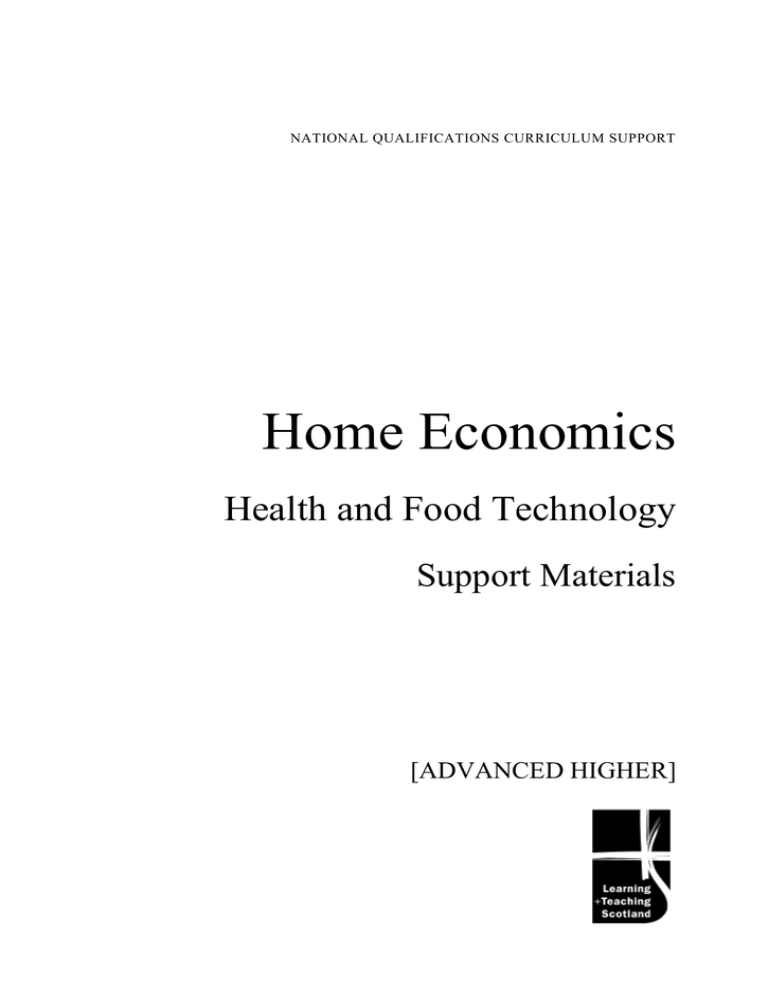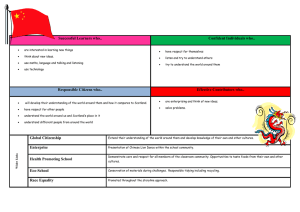Home Economics Health and Food Technology Support Materials
advertisement

NATIONAL QUALIFICATIONS CURRICULUM SUPPORT Home Economics Health and Food Technology Support Materials [ADVANCED HIGHER] The Scottish Qualifications Authority regularly reviews the arrangements for National Qualifications. Users of all NQ support materials, whether published by Learning and Teaching Scotland or others, are reminded that it is their responsibility to check that the support materials correspond to the requirements of the current arrangements. Acknowledgement Learning and Teaching Scotland gratefully acknowledges this contribution to the National Qualifications support programme for Home Economics. © Learning and Teaching Scotland 2009 This resource may be reproduced in whole or in part for educational purposes by educational establishments in Scotland provided that no profit accrues at any stage. 2 HEALTH AND FOOD TECHNOLOGY (AH, HOME ECONOMICS) © Learning and Teaching Scotland 2009 Contents Introduction Section 1: The Food Chain Section 2: Food Politics Section 3: Food Science Section 4: Nutrients and their Effect on the Health and Development of Individuals Section 5: Food Commodities Section 6: Biochemistry, Preservation and Processing Section 7: Psychology of Food Resources HEALTH AND FOOD TECHNOLOGY (AH, HOME ECONOMICS) © Learning and Teaching Scotland 2009 3 INTRODUCTION Introduction National course specification: course details Course content Context: Health and Food Technology Resource management When delivering the course content, it is good practice to use a variety of teaching methods. A greater degree of emphasis should be placed on independent learning, which encourages additional research and reading. To develop a deeper knowledge and understanding of the course content, candidates must access current information from credible sources. Content Elaboration The Food Chain The process of events from production of food through to its consumption, to include: food hygiene and safety issues at each stage in the food chain – primary producers, primary/initial processing, final/secondary processing or manufacturing, transportation, retail, consumer, to include: – types of bacteria and possible sources that may increase the risk of food poisoning within the food chain – control and prevention of microbial growth throughout the food chain – current food safety legislation such as the Food Safety Act 1990 and Food Hygiene (Scotland) Regulations 2006 – the hazard analysis critical control point system – the role of the environment health department products design and quality, to include: – market research (reasons for use, benefits to manufacturer, methods of obtaining data) – stages in product development (concept generation, concept screening, development of prototype, product testing, packaging design, 4 HEALTH AND FOOD TECHNOLOGY (AH, HOME ECONOMICS) © Learning and Teaching Scotland 2009 INTRODUCTION Food Politics Food Science The chemical structure of the main nutrients first production run, marketing plan, product launch) – quality assurance and quality control – use of computer technology in food production EU directives The role of the Food Standard Agency The role of DEFRA/SEERAD Food, nutrition and health issues/policies in Scotland and in the UK – current reports should accessed, eg Hungry for Success, Eating for Health – Meeting the Challenge, Food Standard Agency reports. The impact of nutrition/health, culture, social, economic, and environment factors (eg Fair Trade) on food availability, selection and consumption patterns The chemical structure of: carbohydrates (sugar, starch, non-starch polysaccharides) – monosaccharides, disaccharides and polysaccharides fats and oils – fatty acids and glycerol; unsaturated, monounsaturated, polyunsaturated; essential fatty acids; trans and cis fatty acids proteins – amino acids The nature of food The properties and uses of: constituents in relation to their carbohydrates – solubility, inversion, properties and uses crystallisation, caramelisation, retrogradation of in food manufacture starch pectin gel formation fats and oils – melting characteristics, plasticity related to creaming and shortening properties, hydrogenation of oils, smoke point related to uses as a cooking medium, colloidal systems, emulsifying agents and stabilisers, hydrolytic and oxidative rancidity proteins – colloidal systems, denaturation and factors affecting it, gels and gelatine, Maillard reaction HEALTH AND FOOD TECHNOLOGY (AH, HOME ECONOMICS) © Learning and Teaching Scotland 2009 5 INTRODUCTION Nutrients and their Effect on the Health and Development of Individuals In-depth study of nutrients, their function and the effect on the health and development of individuals at different life stages/special circumstances – pregnancy and lactation, infant/young children, teenagers, adults, elderly vegetarians, weight reduction, sports performance: main nutrients – protein, fats and carbohydrates – functions and effect on health and development micronutrients – functions and effect on health and development antioxidants – role in health inter-relationship of nutrients factors affecting absorption of nutrients Food Commodities Health and dietary diseases –- coronary heart disease, obesity, hypertension, cancer, diabetes, anaemia, bowel disorders, osteomalacia, osteoporosis, dental decay Composition and properties of the following goods in raw and cooked state: fruit and vegetables – structure and texture, changes during ripening and cooking, plant pigments and enzymic browning, sensory qualities, relationship to health meat and fish – structure and texture, post-mortem changes, changes during cooking, meat and fish colour, meat tenderness, sensory qualities, relationship to health dairy food, milk and milk products and eggs – constituents, uses in food preparation, changes during cooking, sensory qualities, relationship to health cereals and baked goods – types, function and uses of rice and pasta, flour, fats and shortenings, sugar, raising agents; changes during cooking, sensory qualities, relationship to health 6 HEALTH AND FOOD TECHNOLOGY (AH, HOME ECONOMICS) © Learning and Teaching Scotland 2009 INTRODUCTION Biochemistry, Preservation and Processing Psychology of Food The role of micro-organisms and enzymes in the development of flavours and textures in food Beneficial effects of micro-organisms and enzymes related to specific foodstuffs – cheese yoghurt, alcoholic drinks, bread Adverse effect of micro-organisms and enzymes in the development of flavours and textures in food Physical and chemical changes in foodstuffs after preservation affecting structure, texture, colour and nutritive value Food additives – preservation, antioxidants, emulsifiers, specific commercial additives, ie anti foaming agents, colour, bleaches, flavour enhancers, nutritional additives The benefits of additives and safeguards regarding their use Organic foods Genetic modification of foods Food irradiation Functional food (health-promoting food) Fast foods, to include: – reasons for growth of the fast food industry – role of technology – impact of fast food on food habits – fast food in a social context, eg school, hospital Influence on food product development Influence on consumers Consumers’ attitude to food issues Role/influence of the media Consumer behaviour HEALTH AND FOOD TECHNOLOGY (AH, HOME ECONOMICS) © Learning and Teaching Scotland 2009 7




